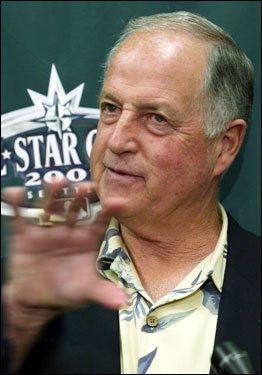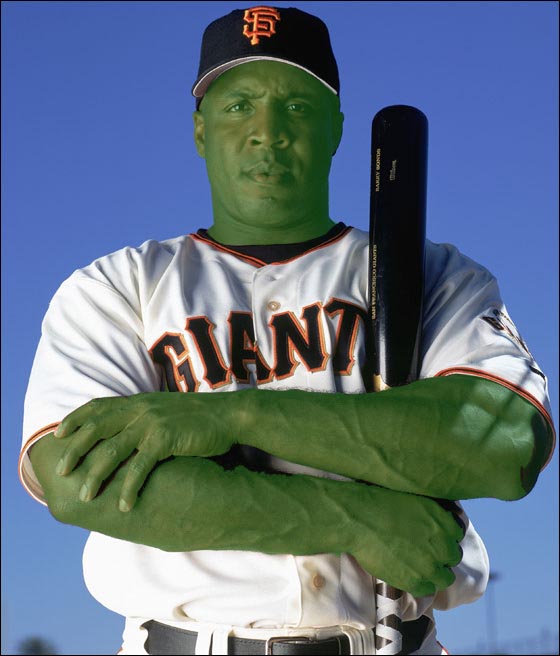 There are many things that people can lose that are very easily replaced. Money, sanity, keys, a wallet are just a few items that can be found or replaced if they are lost.
There are many things that people can lose that are very easily replaced. Money, sanity, keys, a wallet are just a few items that can be found or replaced if they are lost.
Time, however, is not one of them. Lost time will never be replaced and time, as we all know, is our most valuable commodity.
And because time is so precious I decided to turn off ESPN’s presentation of the Home Run Derby last night. I just didn’t have the time to waste in watching something so mindless – it couldn’t even be classified as junk food TV.
Actually, that’s the polite answer I give people (OK, person) who asked me if I caught the Home Run Derby last night. Truth be told, I had the tiniest of interest in knowing how Ryan Howard would perform – a scratch if you will. So when the telecast began and camera zoomed in on San Francisco’s ballpark (I honestly forget which corporation paid to put their tacky billboard on the buildings’ façade – besides, does it matter… don’t they all have the same name at this point?) I had my TV on and was set to devote some time to the event.
But then I heard Chris Berman’s voice.
Click!
Goodnight, folks.
No sense wasting any time on something so drawn out and annoying where the actual action is tucked neatly into the marathon of commercials… or Berman. I’d rather stand next to a giant speaker and listen to The Who circa 1969 and get tinnitus for the rest of my life than to hear Chris Berman speak a sentence. Hey, I’m sure he’s a lovely man with many redeemable qualities and goes out of his way to take care of the little people, etc., etc. But, well, you know what I’m getting at.
I’d rather deal with a case of toenail fungus than watch the Home Run Derby.
Needless to say I have no idea what happened in the Home Run Derby other than it probably lasted too long. Based on a brief scan of the reports from San Francisco’s ballpark it sounds as if I didn’t miss anything at all.
I will, sadly, tune into the All-Star Game tonight. I can’t say I’m too into it and must admit that All-Star Games in general have lost a lot of luster in the days since I was a kid. Back then I actually looked forward to those games. Now it’s just cool to have three to four days without a baseball game.
Jaded and tired? A little.
***
 In an attempt to beat another day of the heat I missed a great broadcaster named Phil Liggett call the action for Stage 3 of the Tour de France. But since Versus plays them over and over in a loop I’m sure I can catch up at a moments’ notice.
In an attempt to beat another day of the heat I missed a great broadcaster named Phil Liggett call the action for Stage 3 of the Tour de France. But since Versus plays them over and over in a loop I’m sure I can catch up at a moments’ notice.
I did catch the report regarding today’s outcome and my first reaction was, “Whoa! Look at Cancellara!”
That’s right, Fabian Cancellara took another stage today and looks like he will be in Yellow when the Tour hits the mountains.
Then it gets serious.
According to reports, Cancellara let it all hang out after the peloton reeled in an early breakaway during the flat, 146-mile stage. With 400 meters to go, the Swiss champ stood up, sprinted and shocked everyone by making it stick.
Meanwhile, it appears as if Cancellara and his CSC teammates are out to defend the Yellow Jersey for as long as they can. Look, Cancellara knows that as a sprint specialist he has very little chance at winning or even holding on to Yellow for more than a few more days, but that doesn’t mean he’s going to give up.
“We're respect this jersey, and we will work to keep it,” he said.
But for now Cancellara has been the man at the Tour. Not only did he smash up the field in the prologue, but also he took a spill and injured his wrist in the Stage 2 wreck with a kilometer to go that highlighted the day’s action. Regardless, the reigning World Champion extended his overall lead by 20 seconds to 33 seconds.
Stage 3 Final
1.) Fabian Cancellara, Team CSC, Switzerland
2.) Erik Zabel, Milram, Germany
3.) Danilo Napolitano, Lampre-Fondital, Italy
4.) Tom Boonen, Quick Step, Belgium
5.) Robbie Hunter, Barloworld, South Africa
6.) Robert Förster, Gerolsteiner, Germany
7.) Robbie McEwen, Predictor-Lotto, Australia
8.) Bernhard Eisel, T-Mobile, Austria
9.) Mark Cavendish, T-Mobile, Great Britain
10.) Heinrich Haussler, Gerolsteiner, Germany
Overall
1.) Fabian Cancellara, Team CSC, Switzerland, in 15:12:08
2.) Andreas Klöden, Astana, Germany, at :33
3.) David Millar Saunier Duval, at :41
4.) George Hincapie, Discovery Channel, at :43
5.) Bradley Wiggins, Cofidis, Great Britain, same time
6.) Vladimir Gusev, Discovery Channel, Russia, at :45
7.) Tom Boonen, Quick Step, at :46
8.) Vladimir Karpets, Caisse d'Epargne, Russia, same time
9.) Thor Hushovd, Credit Agricole, Norway, at :49
10.) Mikel Astarloza Chaurreau, Euskaltel - Euskadi, Spain, same time
Alexandre Vinokourov, the pre-race favorite, is lurking 50 seconds back in 11th place, while top American Levi Leipheimer is a minute behind in 32nd place.
***
 The wire story regarding Ivan Basso’s continued drug testing made me laugh a little. A little background: Basso is currently serving a two-year ban for doping, despite never testing positive, and was forced to take a blood and urine test when testers showed up unannounced at his home last week.
The wire story regarding Ivan Basso’s continued drug testing made me laugh a little. A little background: Basso is currently serving a two-year ban for doping, despite never testing positive, and was forced to take a blood and urine test when testers showed up unannounced at his home last week.
What made it funny (not ha-ha) was a story told by Floyd Landis regarding the same type of deal. In fact, Landis claims that USADA sent a tester to his house when they heard the news that his father-in-law had committed suicide.
Yes, Landis says, they did it on purpose. It’s in his book on page 212.
For the record, USADA has not returned any phone calls or e-mails to present their side of any of the stories or to refute anything. Hey, it’s not like I’m hard to find.
***
Speaking of hard to find, I decided to do some rudimentary research to see if I could find what synthetic testosterone is and how an athlete could use it to aid his performance. Simply using steroids wouldn't help a cyclist, I figured, because muscle mass creates weight and weight is the enemy of any endurance athlete. Besides, the tests apparently show that Floyd Landis used “synthetic testosterone” during his brilliant ride during Stage 17 of last year’s Tour, and using something like that (plus, all the doctors and scientists I have asked have responded with, "It doesn't make sense...)
So what did I find? Try this report by Tom Fine of the Smithsonian Astrophysical Observatory at Harvard University. In it, Fine writes that there is, “no difference between synthetic testosterone and naturally produced testosterone.”
What?
Let me get straight to the point: it's impossible to tell for sure that anyone has taken synthetic testosterone.
Unfortunately, the way Floyd Landis' exogenous testosterone test has been portrayed in the media is as if it were a perfectly definitive test. Like pink for pregnant and white for not (not really a good example, since that isn't so accurate). Such tests do exist: tests with a binary outcome, yes or no, and an extremely low false positive or false negative rate. This is simply not one of them.
There is no difference between synthetic testosterone and naturally produced testosterone – they’re one and the same chemical. Same atoms, in the same configuration, forming the exact same molecule, with identical chemical properties. At least at the atomic level. Once you mix natural and synthetic testosterone, you can't separate them again, any more than you could separate Evian from Poland Springs bottled water after they'd been mixed. Actually that's a bad example. It would be more akin to separating two kinds of distilled water from each other. Even that would be easier than testosterone, since one would presume that distilled water sources don't change rapidly.
At any rate, natural and synthetic testosterone are usually different at the subatomic level. All the carbon in the world has six protons, and almost all the carbon in the world has six neutrons (called carbon-12). Some small portion of the carbon though, has seven neutrons (carbon-13), and an even smaller portion has eight (carbon-14).
Here’s the full link, and here’s another, which claims the test as administered by the French lab and developed by WADA is prone to “false positives.”
This information is all in the Landis wiki, but I easily stumbled upon it with no knowledge that it existed and simply by researching synthetic testosterone.
Again, the USADA has not returned phone calls or e-mails. Nor did they refute these facts during the arbitration hearing in May.
Anyway, back to the original search -- synthetic testosterone commonly come in the following forms:
Testosterone Cypionate (Sold as Depo-Testosterone Cypionate)
The effect of Depo-Testosterone Cypionate is sustained longer in the body than anabolic steroids. A single injection of 200-400 mg is given once every 2-4 weeks, then a rest period of 4 weeks, followed by another injection once every 2-4 weeks.
Transdermal Testosterone (the "Patch")
Testosterone patches allow a slow, steady release of the hormone into the body. The Testoderm patch is applied daily to a man's shaved scrotum. The newer Androderm patch can be applied daily to the upper arms, back, thighs, or abdomen.
Miller and colleagues conducted a 12-week pilot study of an experimental low-dose testosterone patch for women. Fifty-three HIV-positive women who had lost about 10% of their normal body weight, and whose blood levels of testosterone were below the normal reference range took part in the study. They were randomly assigned to receive either a placebo patch, a patch releasing 150 micrograms of testosterone daily, or a patch releasing 300 micrograms of testosterone daily. Although the patches restored testosterone levels to normal, only the women who had used the 150 microgram patch gained weight. Unfortunately, all of the weight gained was fat, not muscle mass.
Nandrolone Decanoate (Sold as Deca-Durabolin, Hybolin Decanoate)
Deca-Durabolin is probably the most popular anabolic used in the treatment of HIV-related weight loss. It has a low rate of side effects and a high anabolic effect. The drug is given by injection into a muscle, at doses ranging from 50-200 mg, every 2-4 weeks for up to 12 weeks. After four weeks off drug, another cycle of treatment can be started. The androgenic side effects of Deca-Durabolin are much milder than those of testosterone.
At doses of up to 100 mg every 3-4 weeks for up to 12 weeks, women may be able to use this drug. If any changes in menstrual periods occur, the drug should be stopped until the cause of such changes is discovered.
Oxandrolone (Oxandrin)
This is an oral anabolic steroid available through the Special Access Programme (formerly EDRP) of the Health Protection Branch of Health Canada. The androgenic effects are very low and side effects are few. The dosage for men is generally 15-40 mg daily and for women 5-20 mg daily.
Phew! I’m growing hair in funny places just typing those sentences.


 The overwhelming reaction to
The overwhelming reaction to 
































